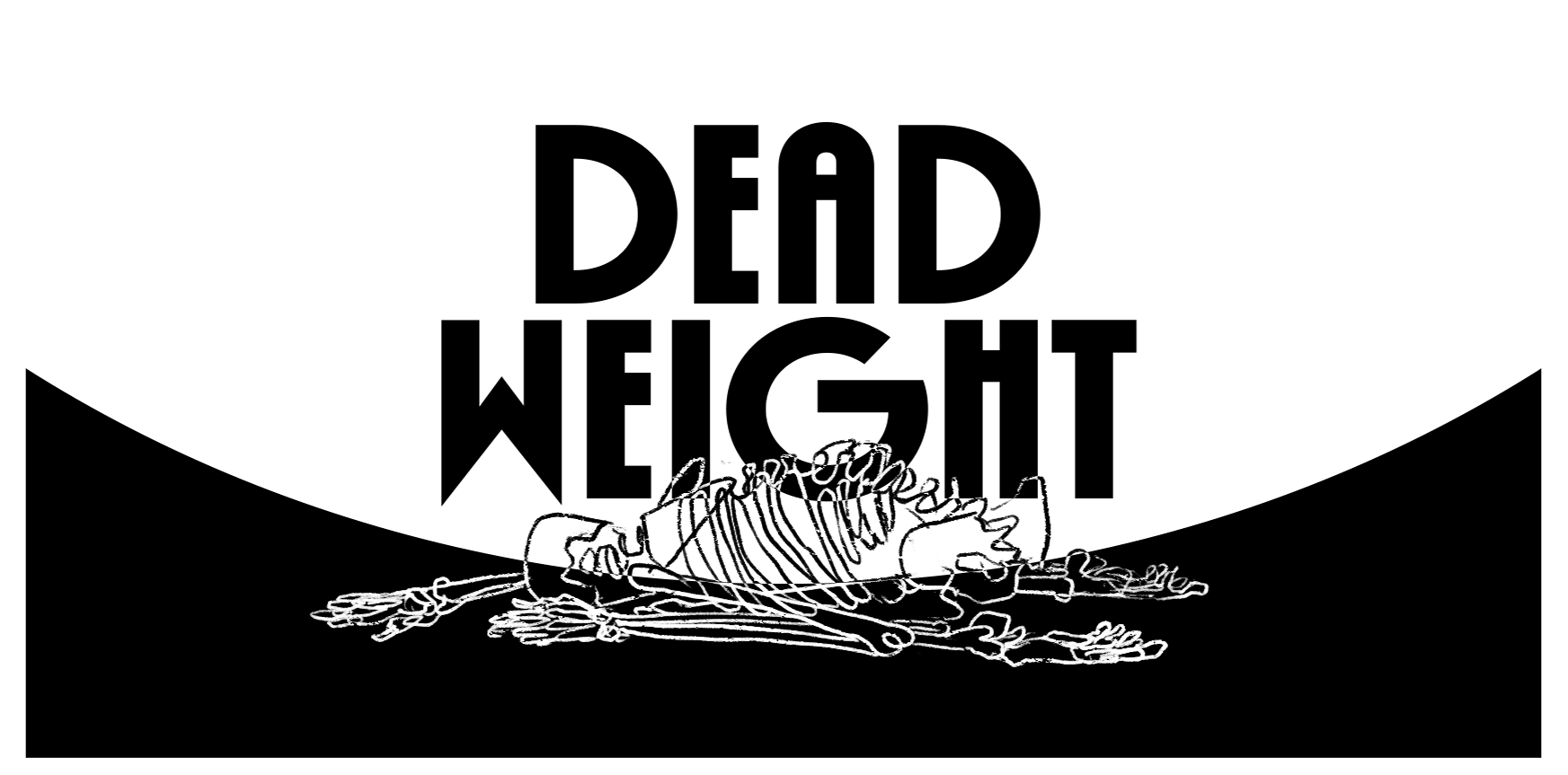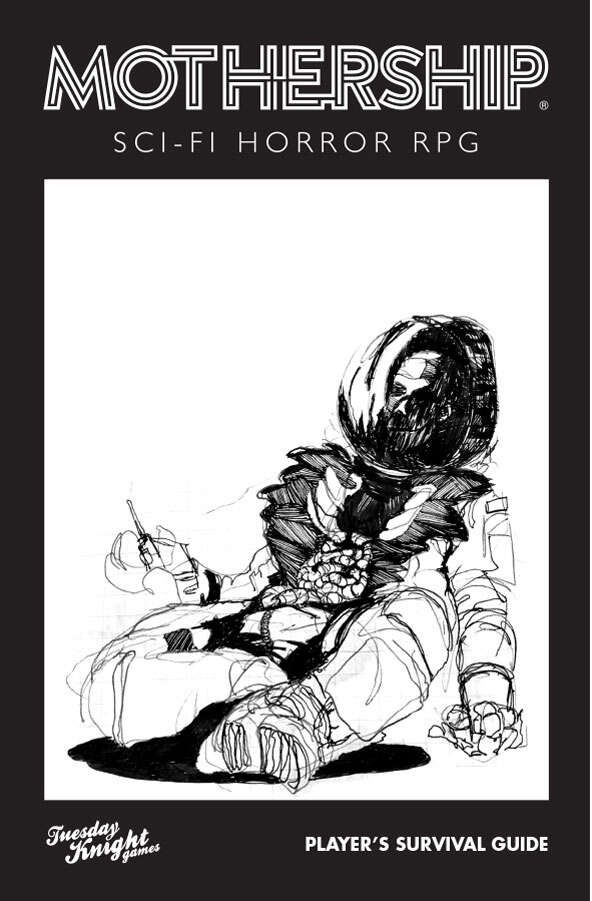Airlock is a series of systemless SF horror adventures created by James Floyd Kelly. I grabbed the first four in the series with an eye towards using them in my Mothership campaign.
All of the adventures in the series are two-page trifolds. The presentation is fairly standardized and they’re all designed with white text on a black, star-speckled background. The result is evocative, but not very friendly on the printer ink. (I actually jumped through some hoops to invert the files before printing them.)
(You may notice that the Mothership logo appears on the cover images for these adventures on DriveThruRPG, but they are definitely systemless and do not use Mothership’s mechanics.)
AIRLOCK #1: THE SIGNAL
The PCs are sent to pick up two data technicians from an isolated, long-term data vault being run by the Kars-Sundar corporation. When they arrive, however, they find one of the techs dead and the android survivor acting erratically. If the PCs investigate, they’ll likely discover that Abbi, the android, was corrupted by a distress call received by the station.
The concept is straightforward enough that you should be able to hack a playable experience out of this one, but The Signal is near-fatally flawed by it continuity being all over the place:
- Kars-Sundar is shutting down the long-term data vault… except then it isn’t any more.
- When the PCs find Abbi alive and Steven missing, Abbi tells them her fake story of what happened… unless it’s a significantly different fake story that’s only implied elsewhere in the adventure?
- As the crew arrives, a radiation storm will knock out the comms and prevent Abbi from exposing them to the Signal… but also she plays it for them when she first meets them.
- Is Abbi’s goal to reach the origin point of the Signal or is it just being randomly destructive and murder-y?
This adventure is supposed to have a direct connection to Airlock #2: Distress Call (which ostensibly takes place at the location where the Signal originated), but it turns out this just creates even more weird continuity glitches.
I’d like to say that all of this makes The Signal a kind of grab bag that a GM could pick elements from build their own version of the adventure. But it’s really just a vague, barely usable mess that becomes more confusing the more time you spend trying to unravel it.
What I want from an adventure – whether one I buy or one I prep myself – is rock solid continuity. I want to know exactly what the situation is, so that we can then inject the PCs into that situation and play to find out the result. So this one misses the mark pretty wide for me.
GRADE: D
AIRLOCK #2: DISTRESS CALL
Following some dubious experiments, the AI core of the Fractal Dream has taken over the ship and killed the crew. Unfortunately, this leaves the AI stuck in space, so it sends out a distress signal to lure in some suckers (i.e., the PCs). Now Katie, the AI, needs to take over the PCs’ ship so that it can escape.
…which would make sense if the crew of the Fractal Dream had managed to disable the ship’s engines before Katie took over. But they didn’t. Instead, shutting down the engine is something the PCs are expected to do.
Maybe the intention here is that Katie is just pretending to be stranded to lure in the unwary? But this would seem to contradict other sections of the text and it’s all very vague. In fact, the biggest problem here is that a lot of Distress Call is just waving generally in the direction of an adventure.
This also means that there’s a lot of blather on the page. For example, there’s four different paragraphs scattered around this two-page trifold, each explaining how Katie has broken free of her programming, is no longer bound by her safety restrictions, and so forth.
But because so much space is wasted on blather, it also means what should be the actual meat of the adventure is short-shrifted. For example, there’s a bit where Kelly writes, “Katie has plenty of offensive weapons – shocks via metal surfaces, electrical overloads, temperature control, and many more.” The adventure would be considerably better if a lot of its blather was placed with actually giving Kelly a concrete, fully realized toolset of fun, dynamic actions the GM could deploy in response to the players.
What’s here isn’t really a firm foundation that you could use to build a playable version of the adventure. It’s more like a quick sketch of what a blueprint of that foundation might look like.
Expect to put a lot of work into this one.
GRADE: D-
AIRLOCK #3: CRYO – SWEET SCREAMS
Cryo: Sweet Screams is a really frustrating adventure to use. (Or, at least, try to use.)
First, the scenario is incorrectly sequenced. There’s a section called “Running the Scenario” which is positioned, on the page, to seemingly be read last, but which has essential information necessary to understand large swaths of the rest of the adventure. But, upon closer inspection, it turns out that reading this section first won’t work, either: There’s no correct reading order here. It’s just a big jumble.
The scenario also promises the GM certain tools, only to fail to deliver on them. Take the “Cast of Characters,” for example. It would be super useful to have this authoritative reference for each character in the adventure, but it turns out that every single character write-up lacks the essential information for the character (e.g., “she’s the bad guy”).
Once I untangled the adventure, though, what I discovered was something that seemed hopelessly overwrought:
The PCs are sent to intercept and redirect a medical intervention ship whose comms array has been damaged.
But that’s not all! The corporation is also reprogramming the ship’s android to get up to mischief, and that obviously goes awry and causes the android to start acting erratic (as androids are wont to do).
But that’s not all! The android isn’t the real bad guy. The real bad guy is the human member of the crew, who has ALSO been infected with a (biological) virus that makes her a psychopath.
Even if you want to roll with this “it’s viruses rewriting personalities all the way down” premise, though, Cryo: Sweet Screams has deeper issues.
The crux of the adventure is, “Durden will slowly exhibit strange behavior once he wakes.” But what is this strange behavior? No idea.
Later, if the PCs watch the news and learn that the vaccination program at the ship’s last stop was botched, “this news will trigger actions in Durden and Talisha.” What are these actions? No idea.
Furthermore, the medical ship’s shuttle “will have some issues that need to be addressed by the crew.” This is, in fact, stated no less than three times across the six panels of the adventure, and the idea is that this will give the PCs something to do while the unspecified “strange behaviors” are happening.
But what are these tasks the PCs are supposed to do?
No idea.
GRADE: F
AIRLOCK #4: DEAD WEIGHT
I’ve concluded, after reviewing dozens of these adventures, that the trifold format is a tricky one. Creators really don’t seem to understand how to organize their information. The front page is often used as if it’s back cover text (which is kind of waste of space in a format where space is quite limited), and then, once you flip open the trifold, it’s a complete crapshoot which order you’re supposed to read the other five panels in.
Some creators seem to have decided to just wave the white flag and simply not include any sort of orientation for the GM. For example, no matter where you begin reading Dead Weight, the text will always just blithely assume that you know what a GH3 is.
If you, too, are wondering what they are, after trawling the text and reassembling the scattered bits of information thrown around with wild abandon, I’m fairly certain the answer boils down to, “A large tribble with legs and teeth.” The GH3s breed incredibly rapidly, and will quickly overwhelm any station or ship they find themselves on, rending every bit of flesh they can find along the way.
As another example of the white flag being waved, take the NPC named Mitchell. In one section he’s been placed in cryosleep. In another, there’s an offhand comment to him “having his own programming.” From this, I assume you’re supposed to conclude that he’s an android, but the adventure never actually says that. There’s a lot of this kind of stuff scattered around the text, creating countless booby traps and lacunae.
Taking a step back, the scenario hook for Dead Weight is that the PCs detect an intermittent signal coming from an abandoned space station which has drifted into deep space. When they board the station to claim the salvage rights, they awaken the GH3s, which have survived in a state of advanced hibernation.
The core premise seems to be that the PCs will conclude that it’s impossible to kill the GH3s faster than the GH3s reproduce! They’ll have no choice but to flee and/or blow up the station!
… except the reality is that the GH3s double their numbers every 8 hours. That’s quite aggressive for a biosphere, but rather less terrifying to a PC with a flamethrower. (In contrast, an ochre jelly in D&D is terrifying because it can split multiple times per round. If it, like the GH3s, split once every 8 hours, it would be considerably less intimidating.)
In fact, this is another example where it’s difficult to understand how the time scale of this adventure is supposed to work at the table: What are the PC supposedly doing during the hours and hours of time the GH3s need to become a meaningful threat? This is something you might be able to solve by prepping some time-consuming guidelines for how long it takes to effectively salvage the station – e.g., repairing thrusters takes 4 hours, etc. – but you’re really swimming uphill at this point to force this adventure into a satisfying experience at the table.
GRADE: D
Note: This adventure should not be confused with Dead Weight, an unrelated Mothership adventure written by Norgad, which I previously reviewed.
CONCLUDING THOUGHTS
There are a lot of problems with these Airlock adventures, and they’re pretty consistent throughout the series. The impression I’m mostly left with is that all of them are more like the concept of an adventure, each remaining, sadly, undeveloped in any meaningful way while the poorly organized trifold format is instead filled with vague, often directionless and repetitive blather.
I was really hoping that these were going to be great. I was very excited when I found the series, which has almost a dozen installments. I thought I’d found something that would keep my Mothership open table supplied with adventures for potentially months.
Unfortunately, I found these first four installments to be essentially unusable and I’ve given up on the series.





















